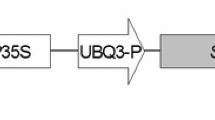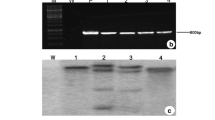Abstract
Osmotin and osmotin-like proteins are stress proteins belonging to the plant PR-5 group of proteins induced in several plant species in response to various types of biotic and abiotic stresses. We report here the overexpression of tobacco osmotin in transgenic mulberry plants under the control of a constitutive promoter (CaMV 35S) as well as a stress-inducible rd29A promoter. Southern analysis of the transgenic plants revealed the stable integration of the introduced genes in the transformants. Real-time PCR analysis provided evidence for the expression of osmotin in the transgenic plants under both the constitutive and stress-inducible promoters. Transgenic plants with the stress-inducible promoter were observed to better tolerate salt and drought stress than those with the constitutive promoter. Transgenic plants when subjected to simulated salinity and drought stress conditions showed better cellular membrane stability (CMS) and photosynthetic yield than non-transgenic plants under conditions of both salinity and drought stress. Proline levels were very high in transgenic plants with the constitutive promoter relative to those with the stress-inducible promoter. Fungal challenge undertaken with three fungal species known to cause serious losses to mulberry cultivation, namely, Fusarium pallidoroseum, Colletotrichum gloeosporioides and Colletotrichum dematium, revealed that transgenic plants with osmotin under control of the constitutive promoter had a better resistance than those with osmotin under the control of the stress-inducible promoter. Evaluation in next generation was undertaken by studying bud break in transgenic and non-transgenic plants under simulated drought (2% polyethylene glycol) and salt stress (200 mM NaCl) conditions. The axillary buds of the selected transgenic lines had a better bud break percentage under stressed conditions than buds from non-transgenic mulberry lines. A biotic assay with Bombyx mori indicated that osmotin protein had no undesirable effect on silkworm rearing and feeding. We therefore conclude that 35S transgenic plants are better suited for both abiotic stress also biotic challenges (fungal), while the rd29A transgenic plants are more responsive to drought.





Similar content being viewed by others
References
Abad LR, D’Urzo MP, Liu D (1996) Antifungal activity of tobacco osmotin has specificity and involves plasma membrane permeabilization. Plant Sci 118:11–23
Aggarwal S, Kanwar K (2006) Comparison of genetic transformation in Morus alba L. via different regeneration systems. Plant Cell Rep 26:177–185
Barthakur S, Babu V, Bansal KC (2001) Overexpression of osmotin induces proline accumulation and confers tolerance to osmotic stress in transgenic tobacco. J Plant Biochem Biotechnol 10:31–37
Bates LS, Waldren RP, Teare ID (1973) Rapid determination of proline for water stress studies. Plant Soil 39:205–207
Bhatnagar S, Khurana P (2003) Agrobacterium tumefaciens mediated transformation of Indian mulberry, Morus indica cv. K2: A time phased screening strategy. Plant Cell Rep 21:669–675
Bhatnagar S, Kapur A, Khurana P (2000) TDZ mediated differentiation in commercially valuable Indian mulberry Morus indica cultivars K2 and DD. Plant Biotechnol 18:61–65
Bhatnagar S, Das M, Khurana P (2002a) TDZ-mediated micropropagation of Indian mulberry cultivars C176 and C776. Indian J Sericult 41:80–83
Bhatnagar S, Kapur A, Khurana P (2002b) Evaluation of parameters for high efficiency gene transfer via particle bombardment in Indian mulberry. Indian J Exp Biol 40:1387–1393
Bhatnagar S, Kapur A, Khurana P (2003) Evaluation of parameters for high efficiency gene transfer via Agrobacterim tumefaciens and production of transformants in Indian mulberry, Morus indica cv. K2. Plant Biotechnol 21:128
Bol JF, Linthorst HJM, Cornelissen BJC (1990) Plant pathogenesis related proteins induced by virus infection. Annu Rev Phytopathol 28:113–138
Campos M, Silva MS, Magalhaes CP, Ribeiro SG, Sarto RP, Vieira EA, Grossi M (2008) Expression in Escherichia coli, purification, refolding and antifungal activity of an osmotin from Solanum nigrum. Microb Cell Fact 7:7
Chavan PD, Karadge BA (1986) Growth, mineral nutrition, organic constituents and rate of photosynthesis in Sesbenia glandiflora L. grown under saline conditions. Plant Soil 92:395–404
Dix PJ, Pearce RS (1981) Proline accumulation in NaCl resistant and sensitive cell lines of Nicotiana sylvestris. Z Pflanzenphysiol 102:243–248
Hong JK, Jung HW, Lee BK, Lee SC, Lee YK, Hwang BK (2004) An osmotin-like protein gene, CAOSM1, from pepper: differential expression and in situ localization of its mRNA during pathogen infection and abiotic stress. Physiol Mol Plant Pathol 64:301–310
Husaini AM, Abdin MZ (2008) Development of transgenic strawberry (Fragaria × ananassa Duch.) plants tolerant to salt stress. Plant Sci 174:446–455
Jami SK, Swati AT, Guruprasad L, Kirti PB (2007) Molecular, Biochemical and structural characterization of osmotin-like protein from black nightshade (Solanum nigrum). J Plant Physiol 164:238–252
Kapur A, Bhatnagar S, Khurana P (2001) Efficient regeneration from mature leaf explants of Indian mulberry via organogenesis. Sericologia 41:207–214
Kasuga M, Liu Q, Miura S, Ymaguchi-Shinozaki K, Shinozaki K (1999) Improving plant drought, salt, and freezing tolerance by gene transfer of a single stress-inducible transcription factor. Nat Biotechnol 17:287–291
Kasuga M, Miura S, Shinozaki K, Yamaguchi-Shinozaki K (2004) A combination of the Arabidopsis DREB1A gene and stress-inducible rd29A promoter improved drought- and low-temperature stress tolerance in tobacco by gene transfer. Plant Cell Physiol 45:346–350
Kavi Kishor PB, Hong Z, Miao GH et al (1995) Overexpression of Δ1-pyrroline-5-carboxylate synthetase increases proline production and confers osmotolerance in transgenic plants. Plant Physiol 108:1387–1394
Kawakami K, Yanagawa H (2003) Illustrated working process of new bivoltine silkworm rearing technology. JICA, India
Khurana P, Kapur A, Bhatnagar S (2003) Studies on morphogenesis and genetic manipulation of Indian mulberry. Indian J Ser 42:1–18
Kim CS, Lee BS, Shin JS, Chung YS, Hyung NI (1997) A simple and rapid method for isolation of high quality genomic DNA from fruit trees and conifers using PVP. Nucleic Acids Res 25:1085–1086
Konowicz AK, Nelson DA, Singh NK, Hasegawa PM, Bressan RA (1992) Regulation of Osmotin gene promoter. Plant Cell 4:513–524
La Rosa PC, Chen Z, Nelson DE et al (1992) Osmotin gene expression is post-transcriptionally regulated. Plant Physiol 100:409–415
Lal S, Bhatnagar S, Khurana P (2006) Screening of Indian mulberry for abiotic stress tolerance and ameliorative effect of calcium on salinity stress. Physiol Mol Biol Plant 12:193–199
Lal S, Gulyani V, Khurana P (2008) Overexpression of HVA1 gene from barley generates tolerance to salinity and water stress in transgenic mulberry (Morus indica). Transgenic Res 17:651–663
Liu D, Raghothama KG, Hasegawa PM, Bressan RA (1994) Overexpression of osmotin in potato delays development of disease symptoms. Proc Natl Acad Sci USA 91:1888–1892
Monteiro S, Barakat M, Piçarra-Pereira MA, Teixeira AR, Ferreira RB (2003) Osmotin and thaumatin from grape: a putative general defense mechanism against pathogenic fungi. Biochem Cell Biol 93:1505–1512
Murashige T, Skoog F (1962) A revised medium for rapid growth and bioassays with tobacco tissue cultures. Physiol Plant 15:473–497
Naik CR, Joshi CL (1983) Ineffectual role of proline metabolism in salt stressed sugarcane leaves. Proc Indian Acad Sci 92:265–269
Nelson D, Raghothama KG, Singh NK, Hasegawa PM, Bressan RA (1992) Analysis of structure and transcriptional activation of an osmotin gene. Plant Mol Biol 19:577–588
Noori SAS, Sokhansanj A (2008) Wheat plants containing an osmotin gene show enhanced ability to produce roots at high NaCl concentration. Russ J Plant Physiol 55:256–258
Nozue M, Cai W, Li L, Xu W, Shioiri H, Kojima M, Saito H (2000) Development of a reliable method for Agrobacterium tumefaciens-mediated transformation of mulberry callus. J Seric Sci Jpn 69:345–352
Onishi M, Tachi H, Kojima T (2006) Molecular cloning and characterization of a novel salt-inducible gene encoding an acidic isoform of PR-5 protein in soybean (Glycine max). Plant Physiol Biochem 44:574–580
Ouyang B, Chen YH, Li HX, Qian CJ, Huang SL, Ye ZB (2005) Transformation of tomatoes with osmotin and chitinase genes and their resistance to Fusarium wilt. J Hort Sci Biotech 80:517–522
Parkhi V, Kumar V, Sunilkumar G, Campbell LM, Singh NK, Rathore KS (2009) Expression of apoplastically secreted tobacco osmotin in cotton confers drought tolerance. Mol Breed 23:625–639
Rajam MV, Chandola N, Goud PS (2007) Thaumatin gene confers resistance to fungal pathogens as well as tolerance to abiotic stresses in transgenic tobacco plants. Biol Plant 51:135–141
Rao AA (2002) Conservation status of mulberry genetic resources in India. Paper contributed to Expert Consultation on Promotion of Global Exchange of Sericultural Germplasm Resources, Satellite session of 19th ISC Congress. Bangkok, Thailand, pp 21–25
Sairam RK, Rao KV, Srivastava GC (2002) Differential response of wheat genotypes to longterm salinity stress in relation to oxidative stress, antioxidant activity and osmolyte concentration. Plant Sci 163:1037–1046
Salzman RA, Tikhonova I, Bordelon BP, Hasegawa PM, Bressan RA (1998) Coordinate accumulation of antifungal proteins and hexoses constitutes a developmentally controlled defence response during fruit ripening in grape. Plant Physiol 117:465–472
Sambrook J, Fritsch EF, Maniatis T (1989) Molecular cloning: a laboratory manual, 2nd edn. Cold Spring Harbor Laboratory Press, New York
Sarad N, Rathore M, Singh NK, Kumar N (2004) Genetically engineered tomatoes: new vista for sustainable agriculture in high altitude regions. In: Proc 4th Int Crops. Brisbane, Australia
Singh NK, Bracker CA, Hasegawa PM, Handa AK, Buckel K, Hermodson MA, Pfankoch E, Regnier FE, Bressan RA (1987) Characterization of osmotin: a thaumatin-like protein associated with osmotic adaptation in plant cells. Plant Physiol 85:529–536
Singh NK, Nelson DE, Kuhn D et al (1989) Molecular cloning of osmotin and regulation of its expression by ABA and adaptation to low water potential. Plant Physiol 90:1096–1101
Taj G, Kumar A, Bansal KC, Garg GK (2004) Introgression of osmotin gene for creation of resistance against Alternaria blight by perturbation of cell cycle machinery. Indian J Biotechnol 3:291–298
Tewari A, Bhatnagar S, Khurana P (1999) In vitro response of commercially valuable varieties of Morus sp.to thiadizuron and activated charcoal. Plant Biotechnol 16:413–417
Velazhahan R, Datta SK, Muthukrishnan S (1999) The PR-5 family: thaumatin-like proteins. In: Datta SK, Muthukrishnan S (eds) Pathogenesis-related proteins in plants. CRC Press, Boca Raton, pp 107–129
Vigers AJ, Roberts WK, Selitrenikoff CP (1991) A new family of plant antifungal proteins. Mol Plant Micro Interact 4:315–323
Woloshuk CP, Meulenhoff JS, Sela-Buurlage M, van den Elzen PJM, Cornelissen BJC (1991) Pathogen-induced proteins with inhibitory activity toward Phytophthora infestans. Plant Cell 3:619–628
Wu J, Khan AA, Shih CY, Shih DS (2001) Cloning and sequence determination of a gene encoding an osmotin-like protein from strawberry (Fragaria X Ananassa Duch.). DNA Seq 12:447–451
Yoshida S, Shirata A (1998) Mulberry anthracnose. In: Kishi K (ed) Plant diseases in Japan. Zenkoku Nouson Kyouiku Kyoukai, Tokyo, p 195
Zhang Y, Shih DS (2007) Isolation of an osmotin-like protein gene from strawberry and analysis of the response of this gene to abiotic stresses. J Plant Physiol 164:168–177
Zhu B, Chen THH, Li PH (1993) Expression of an ABA-responsive osmotin-like gene during the induction of freezing tolerance in Solanum commersonii. Plant Mol Biol 21:729–735
Zhu B, Chen THH, Li PH (1995) Expression of three osmotin-like protein genes in response to osmotic stress and fungal infection in potato. Plant Mol Biol 28:17–26
Zhu B, Chen TH, Li PH (1996) Analysis of late blight disease resistance and freezing tolerance in transgenic potato plants expressing sense and antisense genes for an osmotin-like protein. Planta 198:70–77
Acknowledgments
This work was financially supported by Department of Biotechnology, Government of India.
Author information
Authors and Affiliations
Corresponding author
Electronic supplementary material
Below is the link to the electronic supplementary material.
Rights and permissions
About this article
Cite this article
Das, M., Chauhan, H., Chhibbar, A. et al. High-efficiency transformation and selective tolerance against biotic and abiotic stress in mulberry, Morus indica cv. K2, by constitutive and inducible expression of tobacco osmotin . Transgenic Res 20, 231–246 (2011). https://doi.org/10.1007/s11248-010-9405-6
Received:
Accepted:
Published:
Issue Date:
DOI: https://doi.org/10.1007/s11248-010-9405-6




